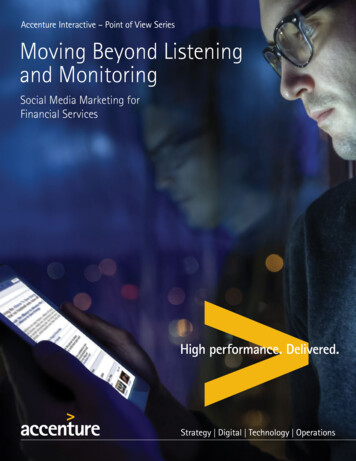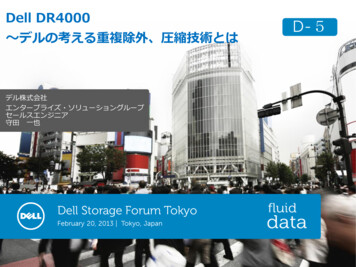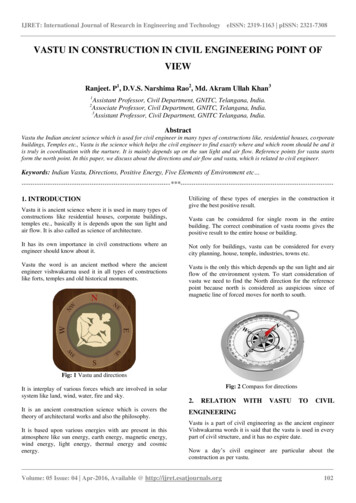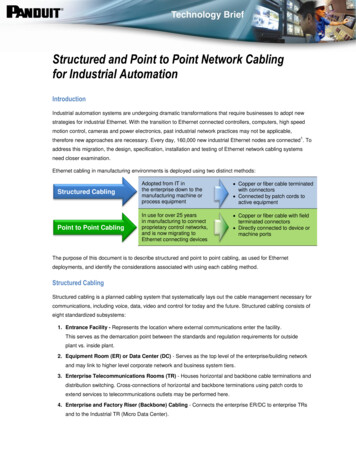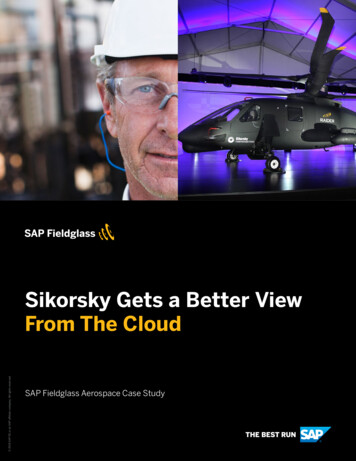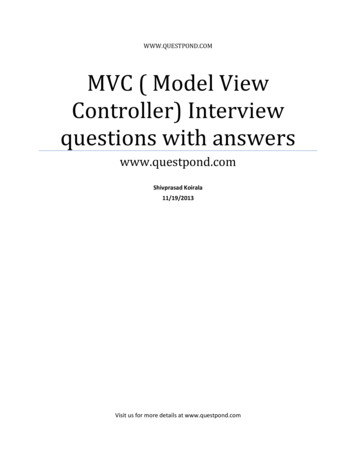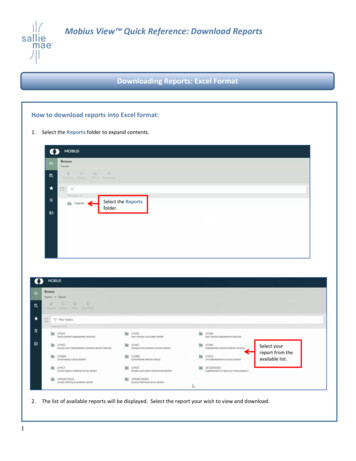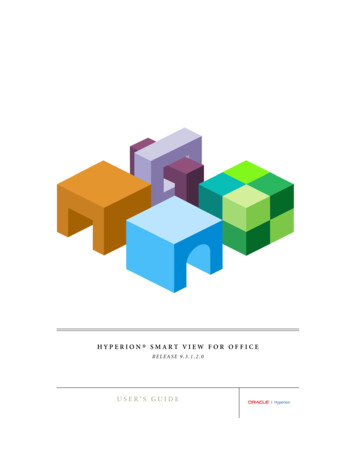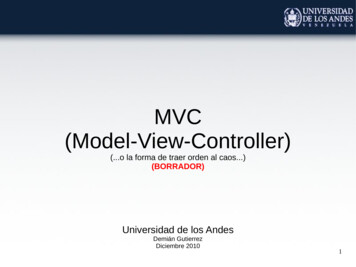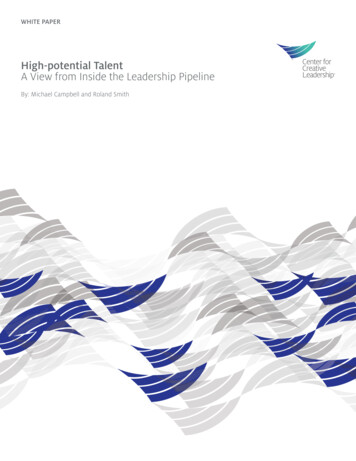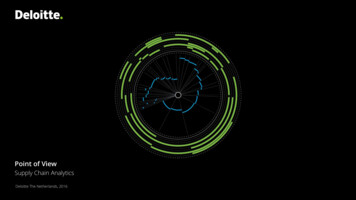
Transcription
Point of ViewSupply Chain AnalyticsDeloitte The Netherlands, 2016
Gustav Mahlerlaan 2970Gustav29701081 LAMahlerlaanAmsterdam1081LA AmsterdamThe NetherlandsThe NetherlandsT. 31 88 288 2888www.deloitte.comDear reader,Deloitte maintains market-leading global Supply Chain and Analytics practices withextensive experience in Supply Chain Analytics, see our webpage. Based on ourexperience, we have insights in the latest (technological) developments, andunderstand the impact of these developments on your businessTable of contentpageSupply Chain trends3Digital Supply Networks6In this point of view we want to demonstrate one of the latest developments in theSupply Chain landscape; data analyticsSupply Chain Analytics13Analytics approach15We will elaborate on relevant Supply Chain trends and the rise of Digital SupplyNetworks, which increases both the need and the possibilities to use data analyticsOur credentials17Why Deloitte?38The possibilities for using data analytics are mapped on our Supply Chain Analyticsframework, that covers all parts of the end-to-end Supply Chain. Examples are theuse of machine learning to better predict demand and using data visualization toprovide end-to-end insight in the supply and enable better decision-makingWe hope you enjoy reading our Point of View,Robert Jan HuizingNaser BakhshiGuido DiepenLantos PinIris van der HeijdenDeloitte NL - SupplyChain StrategyDeloitte NL - Analytics &Information ManagementDeloitte NL - Analytics &Information ManagementDeloitte NL - SupplyChain StrategyDeloitte NL - SupplyChain Strategy
Supply Chain trendsDigital Supply NetworksSupply Chain AnalyticsAnalytics approachOur credentialsSupply Chain trendsWhy Deloitte?Previous NextTracker is an interactive menuDeloitte's Point of View on Supply Chain Analytics3
Supply Chain trendsTwo key trends currently impacting the Supply Chain are related to the rise ofexponential technologies in our societySupply Chain trendsDigital Supply NetworksSupply Chain AnalyticsIncreasing amount ofdata and powerfulprocessing toolsAccelerated influx ofdisrupting technologiesMore focus ontransparency, quality andsustainabilityProducts brought tomarket via convergentbusiness modelsIncreasing globalizationand continued(economic) volatility Efficiently organize thereverse logisticsprocess Digitalize and integrateprocesses to provide a‘seamless’ experience Gain insight in thebiggest Supply Chainrisks and mitigate themby calculating scenarios Optimally design crossborder Supply ChainnetworksAnalytics approachOur credentialsWhy Deloitte? Use artificialintelligence to improvedecision-making andinteroperabilitythroughout the SupplyChain Attract skilled talent tooptimally use data andadvanced analyticsmethods Exploit ‘Internet of Provide insight in theThings’ for integrationorigins of productsand cost-reduction inusing blockchaintransportation Optimize on Use new technologiessustainability metrics(e.g. 3D printing,like CO2 emissionsrobotics and self-drivingcars) to streamline and/or change the SupplyChainPrevious NextTracker is an interactive menuDeloitte's Point of View on Supply Chain Analytics4
Supply Chain trendsThe rise of exponential technologies has created a burning platform: disrupt orbe disruptedSupply Chain trendsExponential technology change is disrupting Supply Chains across all industriesDigital Supply Networks 1,245 perGbpsSupply Chain AnalyticsAnalytics approachOur credentialsWhy Deloitte?Cost of Performance 569 per GBBandwidth 10 222 per milliontransistors1992Storage 0.01Computing 0.06TodayPrevious NextTracker is an interactive menuDeloitte's Point of View on Supply Chain Analytics5
Supply Chain trendsDigital Supply NetworksSupply Chain AnalyticsAnalytics approachOur credentialsDigital Supply NetworksWhy Deloitte?Previous NextTracker is an interactive menuDeloitte's Point of View on Supply Chain Analytics6
Digital Supply NetworksIn the 4th industrial revolution, leading companies are combining informationtechnology and operations technology to create value in new and different waysSupply Chain trendsWhy Deloitte?IndustrializationElectricity andassembly lines Mass manufacturingand improvedinfrastructureOptimize Traditional Objectives ronicAutomationComputers andInternet Connectivity Access toinformation andenhanced decisionmaking capability and New Objectives Revenue4th Industrial RevolutionOur credentialsPower GenerationSteam engines andhydraulic power Productivity andindustrialization1970s to 2000sAnalytics approachLate 18th centurySupply Chain AnalyticsEarly 20th centuryDigital Supply NetworksDigital SupplyNetworksVast network ofcyber-physicalsystems Connectedproducts, customersandsupply chain By Better s NextTracker is an interactive menuDeloitte's Point of View on Supply Chain Analytics7
Digital Supply NetworksIt transforms the traditional, linear Supply Chain nodes into a set of dynamicnetworks, allowing dramatically increased differentiationSupply Chain trendsTraditional Supply ChainDigital Supply NetworkPlanDigital Supply NetworksSupply Chain AnalyticsDeliverCognitive PlanningSupportQuality SensingAnalytics approachOur credentialsWhy Deloitte?DigitalCoreDevelopPlanSourceMakeDeliver3D PrintingSensor-driven ReplenishmentSupportMakeDevelopSourcePrevious NextTracker is an interactive menuDeloitte's Point of View on Supply Chain Analytics8
Digital Supply NetworksIn such networks, a continuous flow of information, goods and services existsbetween the physical and digital world – a ‘digital mirror’ of the physical worldSupply Chain trends1 Physical to Digital: Capture signals and data from thephysical world to create a digital recordDigital Supply NetworksSupply Chain Analytics2 Digital to Digital:Exchange and enrichmentof information usingadvanced analytics,artificial intelligence andmachine learning to drivemeaningful insightsAnalytics approachOur credentialsPhysicalDigitalWhy Deloitte?3 Digital to Physical: Deliver information in automated and moreeffective ways to generate actions and changes in the physicalworldPrevious NextTracker is an interactive menuDeloitte's Point of View on Supply Chain Analytics9
Digital Supply NetworksOne of the biggest opportunities for companies in preparing for the disruptionby Digital Supply Networks lies in the usage of Supply Chain AnalyticsSupply Chain trends1Supply Chain AnalyticsopportunitiesThe digital ‘mirror’ that reflects the physical world creates enormous amounts of data, whichmust be safely stored, easily accessed and dynamically analyzed to gain new insights andimprove (collective) decision-making across the network2New workforce skillsand capabilitiesNew skills and capabilities are required to understand and engage with all aspects of DigitalSupply Networks. These are skillsets which are already in short supply and you will face a newhost of competitors in the talent acquisition process3Cyber security riskThe interconnectedness of Digital Supply Networks creates exposure to data breaches, whichcan be detrimental (possibly catastrophic) to operations and create a negative brand association4Reliance on ecosystemof Supply Chain andtechnology partnersCreating Digital Supply Networks requires reliance on a broader set of collaborators andtechnologies, which increases value opportunities but also complexity within the supplyecosystems5Agile systemsdevelopment &deploymentMany companies have organizations and processes in place for implementing technologysystems. These processes are often robust, as they include a long timeline of designing, testing,building an on premise solutionDigital Supply NetworksSupply Chain AnalyticsAnalytics approachOur credentialsWhy Deloitte?Previous NextTracker is an interactive menuDeloitte's Point of View on Supply Chain Analytics10
Digital Supply NetworksTo accommodate the flow of information between both worlds, an integratedDigital Stack architecture is requiredSupply Chain trendsDigital StackDigital Supply NetworksDigital Stack componentsInsights& StrategyBusiness insights, AI, and analyticsto better sense, predict andanticipate supply chain issuesDecisionSupportModeling, and scenarioanalytics to support betterdecisions for business unitsVisibilityAggregate data for end-to-end visibilitythat enables prioritized actionsBusinessProcessAutomated processes for standardizedprocesses and simple, relatable data;retire multiple applicationsData Integration& ConnectivityIntegrated nodes to create a single pointof connectivity to the supply network;flexibility to add and switch suppliersNetwork DataSynchronizationSynchronized data gathering to reducecost for storage and improve dataavailability through Enterprise widedata warehouse accessSupply Chain AnalyticsAnalytics approachWhy Deloitte?Information flowOur credentialsPrevious NextTracker is an interactive menuSupply Chain Analytics span of controlDeloitte's Point of View on Supply Chain Analytics11
Digital Supply NetworksWhich is characterized by an advanced technology infrastructure (Digital Core)that enables the usage of Supply Chain Analytics to improve decision-makingSupply Chain trendsSupply Chain AnalyticsSupply Chain AnalyticsAnalytics approachOur credentialsSupply Chain AnalyticsDigital Supply NetworksDigital StackThe Digital Core at theheart of the Digital SupplyNetwork allows the usageof Supply Chain Analyticsto gain detailed insightsin its performance andidentify areas ofperformanceimprovementDigital CoreWhy Deloitte?Digital CoreNew Data SourcesLlamasoft, Sourcemap, Kinaxis,O9, One Network, GE Predix,SAP APO, GT Nexus, SASTableau, Clearlight, Qlik View,Microsoft Power BI, Spotfire,Sisense, AlteryxAppian, Software AG, AuraPortal,Oracle, SAP, TIBCO Software, SAPAribaSuppliersSignalsTracker is an interactive menuIBM Watson, Elementum,Amazon QuickSight, ApacheMahoutProducts Consumers SupportExisting SystemsPrevious NextSample ecosystem playersSystem of RecordNote: There are several companies (e.g. GE Predix, SAP) that compete in multiple or all layers ofthe Digital StackSAP / SAP Hana, Microsoft Azure,Amazon Web services, Hadoop,Google CloudDeloitte's Point of View on Supply Chain Analytics12
Supply Chain trendsDigital Supply NetworksSupply Chain AnalyticsAnalytics approachOur credentialsSupply Chain AnalyticsWhy Deloitte?Previous NextTracker is an interactive menuDeloitte's Point of View on Supply Chain Analytics13
Supply Chain AnalyticsDeloitte has vast data analytics experience in the Supply Chain landscape –shown in our Supply Chain Analytics frameworkSupply Chain trendsDigital Supply NetworksSupply Chain AnalyticsAnalytics approach Delivery Lane AnalysisNetwork DesignData-based Warehouse DesignAdvanced Transport OptimizationLogistics OutsourcingCost-to-Serve analysisReturns prediction and trackingPlanTracker is an interactive menu Supply Chain Diagnostics Supply Chain Visualization Supply Chain Risk AnalysisDigitalCore Advanced Production SchedulingMakePrevious NextIntegrated Business PlanningAdvanced inventory planningSKU analysis and rationalizationDemand sensingSupportDeliverOur credentialsWhy Deloitte? OTIF analysis Scenario Modelling for StrategicSourcing Procure to Pay Optimization Source Cost Analysis Optimization of order allocationNote: A selection of Deloitte’s credentials in these areas of Supply Chain Analytics are listed inthe ’Our credentials’ section, page 17DevelopSource Supply Chain Sustainability Supply Chain Analytics Roadmap Supply Chain of the Future WorkshopDeloitte's Point of View on Supply Chain Analytics14
Supply Chain trendsDigital Supply NetworksSupply Chain AnalyticsAnalytics approachOur credentialsAnalytics approachWhy Deloitte?Previous NextTracker is an interactive menuDeloitte's Point of View on Supply Chain Analytics15
Analytics approachDeloitte’s comprehensive and flexible methodology for analytics projects ensureswe can deliver business critical insights within time and budgetSupply Chain trendsA typical analytic Insights project takes 8 to 12 weeks following three main phases connected to our approachDigital Supply NetworksSupply Chain AnalyticsUnderstandAnalyzeInsights2-3 weeks4-6 weeks2-3 weeksAnalytics approachApproachOur credentialsOur structured approach has been built up from our experience in analytical engagements. It comprises of six steps to maximizeproject oversight. Each step allows looping back to previous steps to apply the insights gained in subsequent stepsWhy Deloitte?Assess CurrentSituationAcquire &Understand DataPrepare &Structure DataAnalyze & ModelEvaluate &InterpretReport &ImplementCritical success factorsPrevious NextTracker is an interactive menuTo ensure maximal knowledge transfer in both ways we would need to work closely with key experts in client’s business and ITdepartments. Rapid access to potentially disparate source data and support in understanding the data is essential in order to build upthe data structures required for the analytical modelsDeloitte's Point of View on Supply Chain Analytics16
Supply Chain trendsDigital Supply NetworksSupply Chain AnalyticsAnalytics approachOur credentialsOur credentialsWhy Deloitte?Previous NextTracker is an interactive menuDeloitte's Point of View on Supply Chain Analytics17
Supply Chain AnalyticsDeloitte has vast data analytics experience in the Supply Chain landscape – aselection of our experience shown on the next pagesSupply Chain trendsDigital Supply NetworksSupply Chain AnalyticsAnalytics approach Delivery Lane Analysis (page 31)Network Design (32)Data-based Warehouse Design (33)Advanced Transport Optimization (34)Logistics Outsourcing (35)Cost-to-Serve analysis (36)Returns prediction and tracking (37)PlanTracker is an interactive menu Supply Chain Diagnostics (20) Supply Chain Visualization (21; 22) Supply Chain Risk Analysis (23)DigitalCore Advanced P
Oracle, SAP, TIBCO Software, SAP Ariba SAP / SAP Hana, Microsoft Azure, Amazon Web services, Hadoop, Google Cloud e Products Consumers Support New Data Sources Existing Systems Signals System of Record Suppliers The Digital Core at the heart of the Digital Supply Network allows the usage of Supply Chain Analytics to gain detailed insights in its performance and identify areas of
